Smartcard MCU Market Size
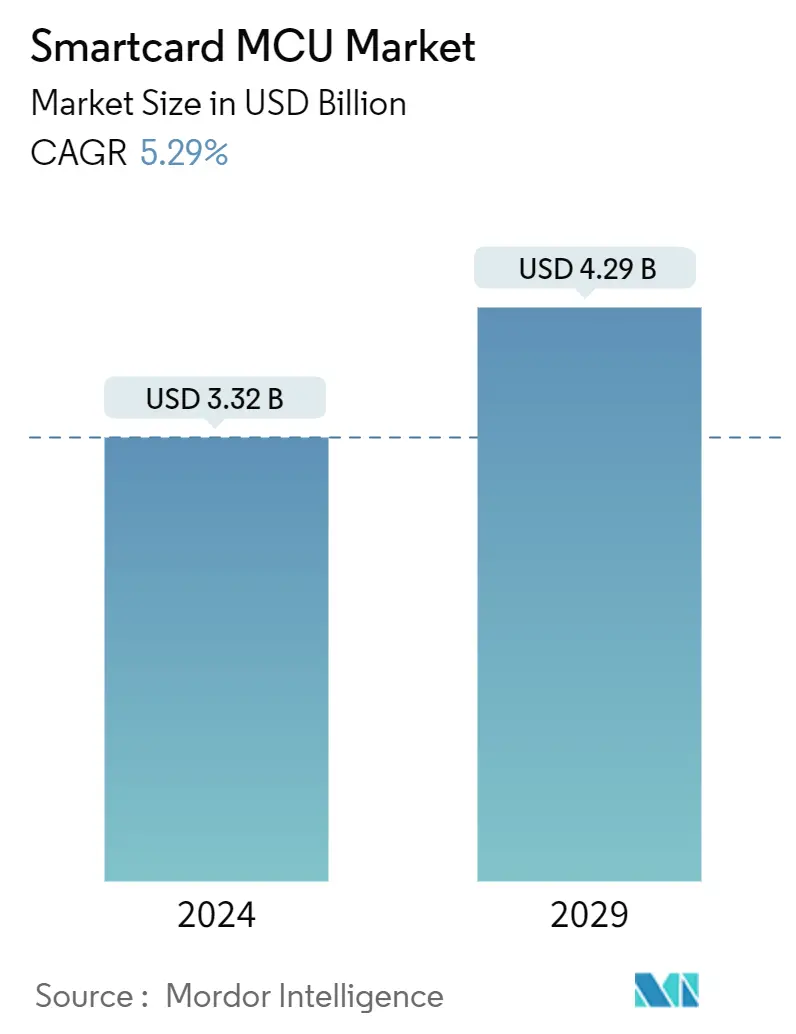
| Study Period | 2019 - 2029 |
| Market Size (2024) | USD 3.32 Billion |
| Market Size (2029) | USD 4.29 Billion |
| CAGR (2024 - 2029) | 5.29 % |
| Fastest Growing Market | Asia Pacific |
| Largest Market | Asia Pacific |
Major Players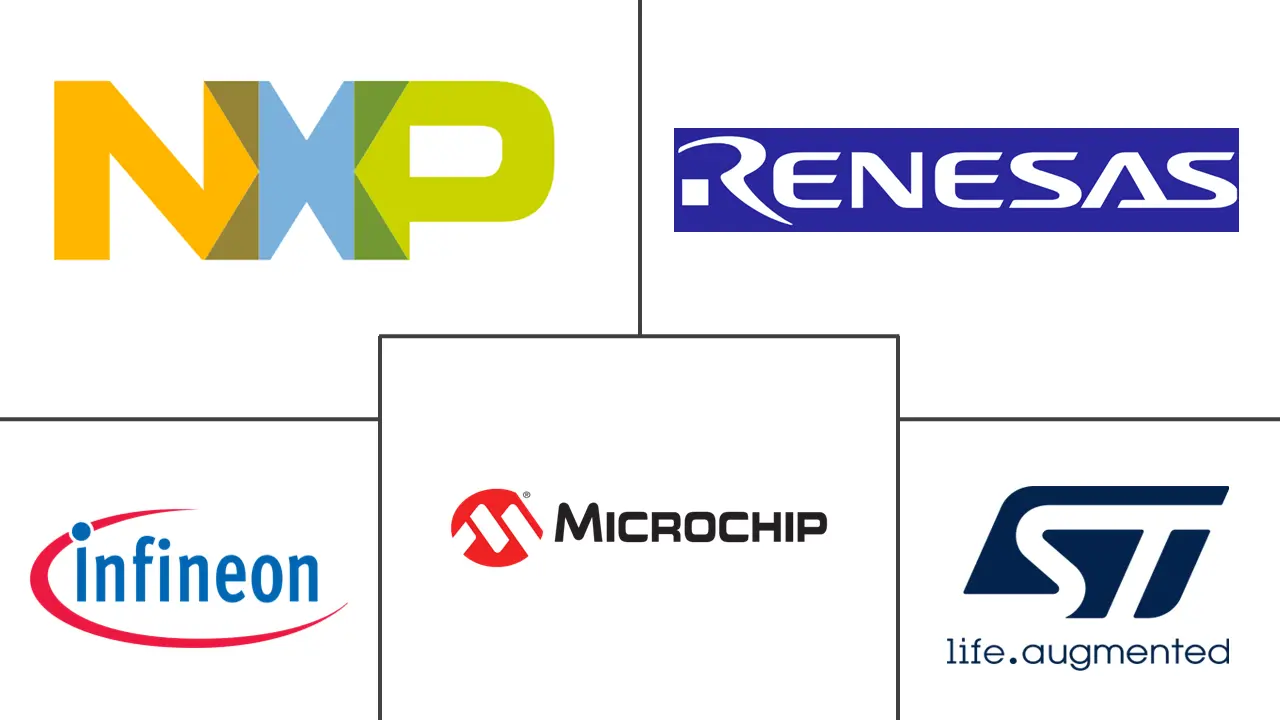
*Disclaimer: Major Players sorted in no particular order |
Smartcard MCU Market Analysis
The Smartcard MCU Market size is estimated at USD 3.32 billion in 2024, and is expected to reach USD 4.29 billion by 2029, growing at a CAGR of 5.29% during the forecast period (2024-2029).
- The Internet's rapid expansion has made electronic shopping a real possibility among computer users if not a habit; nevertheless, the present business model used in electronic commerce applications cannot fully exploit the potential of the electronic medium.
- The market growth is driven by the increasing development in RFID technology and NFC in smart cards. Contactless smart cards, leveraging the rapid evolution of radio frequency identification (RFID) technology, are gaining popularity. These cards use RFID technology to process transactions. Key vendors are concentrating on introducing contactless smart cards due to their growing consumer demand, which is expected to fuel market growth.
- The proliferation of smart card technology in the transportation industry, along with growing government investments in implementing digital technology, drives market growth. Electronic smart cards are now viable alternative payment methods for transport operators. In recent years, many operators and system providers have initiated smart card-based systems either to complement or replace existing payment methods.
- Furthermore, security and miniaturization represent the two fastest-evolving aspects of smart card technology. With global migration to higher security EMV banking cards, the newest generation of smart cards boasts full on-chip cryptography, significantly enhancing industry-wide card security.
- Moreover, smart cards are increasingly being miniaturized into diverse form factors like mini-tags and smart wearables. These trends will persist as smart cards are increasingly employed as a two-factor credential alongside phones or biometrics.
- The primary challenge facing smart cards is their security level. To realize their full potential, smart cards must interact with various interfaces. However, a security issue arises concerning public perception; people might need to be made aware of the personal details stored on their cards, assuming they are secure. Yet, there needs to be an awareness that information extracted from smart cards is collected and analyzed elsewhere.
Smartcard MCU Market Trends
BFSI to Witness the Growth
- Smart cards for banking and finance now incorporate specialized integrated circuit cards, ensuring robust security measures. These cards house embedded memory chips and microprocessors, enabling secure data storage and processing. They serve diverse functions in financial activities, including transaction authentication, secure access to online banking services, debit and credit card payments, and contactless payment methods.
- The digitization of payment processes owes much to the Internet's development and the emergence of e-commerce. This transition has led to a plethora of electronic payment options, ranging from payment cards (credit and debit) to digital wallets, electronic cash, and contactless payment methods. The surging popularity of mobile payment services is currently undergoing a transitional phase, poised for future technological advancements. These advancements in payment methods are expected to leverage smart card technology, driving market growth.
- Smart cards featuring MCUs (microcontroller units) are commonly used alongside personal identification numbers (PINs). They serve multiple purposes, enhancing organizational security, acting as multifactor authentication (MFA) tokens, and verifying single sign-on (SSO) users, ultimately facilitating passwordless authentication. The rapid increase in online transactions, partly due to the pandemic and the rise of alternative payment methods like Apple Pay, Klarna, Stripe, and Amazon Pay, has surpassed face-to-face transactions. These advancements significantly expand the potential applications of smart card technology in the industry.
- EMV card technology, employing compact yet robust chips integrated into credit and debit cards, is increasingly recognized as an evolving payment solution. EMV, an acronym for Europay, Mastercard, and Visa, denotes the collaborative efforts behind this industry standard. These advanced cards are indispensable in fortifying businesses and customer security by mitigating credit card fraud losses, fostering a more secure payment environment, and ensuring a safer transactional experience.
- Most new EMV cards and chip-based readers come equipped with near-field communication (NFC) technology, enabling contactless payments. Customers can wave their cards across the reader, facilitating quicker and more secure transactions. Besides heightened security, EMV smart cards offer enhanced speed and convenience by securely communicating between the card and the terminal, benefitting both merchants and cardholders.
- EMV cards, featuring chips employing cryptographic algorithms, heighten transaction security by uniquely encrypting data with each use. During card-present transactions, these cards employ a dual verification process, requiring the physical card and the customer's PIN. This authentication method validates the cardholder, enabling the confirmation and approval of the one-time password (OTP) generated by the chip. Anticipated technological advancements are poised to stimulate extensive demand for smart card technology, propelling market growth in the foreseeable future.
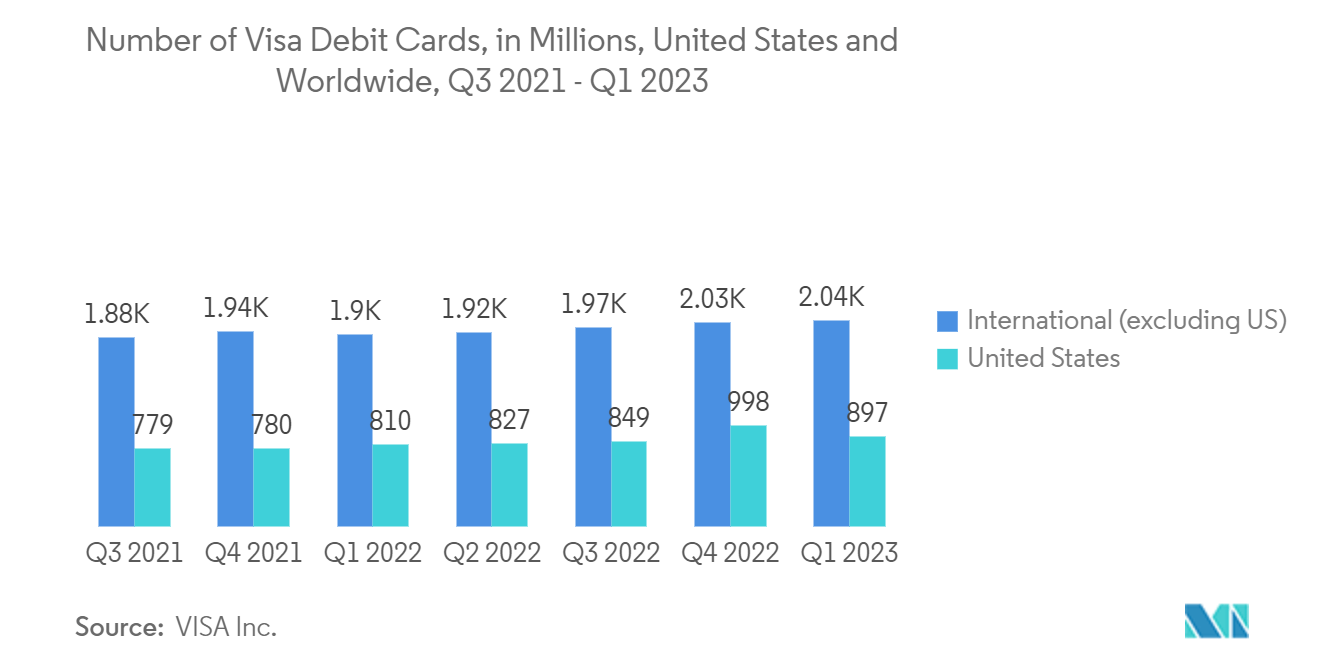
Asia-Pacific Expected to Hold Significant Market Share
- The adoption of smart card technology in the APAC is experiencing a change towards multi-application smart cards. These cards are being used for multiple purposes, such as payment, identification, and access control, resulting in greater convenience and efficiency for consumers and cost savings for businesses. Moreover, the need for enhanced security features in smart cards has been growing, particularly with the increase in online transactions.
- Smart card technology has gained widespread popularity in India, owing to the government's focus on digitalization. Almost every Indian citizen probably possesses some form of a smart card. These cards are extensively utilized in various sectors, such as banking, healthcare, transportation, and government identification. For example, smart cards are employed for Driving License/Vehicle Registration Certificate (DL/RC), Multi-purpose National Identity Card (MNIC), Rashtriya Swasthya Bima Yojana (RSBY), and Electronic Passport (e-Passport) in India. The increasing adoption of smart card technology in the region is expected to drive the market.
- The near future is expected to witness a surge in the demand for digital payments and smart cards. The Indian BFSI sector is progressively embracing smart card technology, which is anticipated to provide substantial prospects for MCU makers. Notably, insurance companies operating under the Rashtriya Swasthya Bima Yojana (RSBY) and business correspondents for banks are producing millions of chip cards, making India one of the swiftest adopters of smart card technology. Such factors are expected to drive the demand for the market.
- In addition, implementing smart card technology in India has benefited social welfare programs and transportation systems, as it has improved the quality of life for the general public. An example is the Shakti smart card scheme, which enables women residing in Karnataka to travel freely on non-premium buses. According to EMVCo, the Smart Card India initiative has reduced transaction time, minimized losses, and increased satisfaction among beneficiaries. The utilization of innovative technologies like smart cards has the potential to enhance future welfare programs.
- Smart cards equipped with MCUs that possess the ability to establish short-range wireless connections have the potential to be utilized in contactless payment systems. As the usage of contactless cards continues to rise and their adoption rates increase within the region, the volume of payments conducted through this method has experienced a substantial surge, consequently generating a notable market demand.
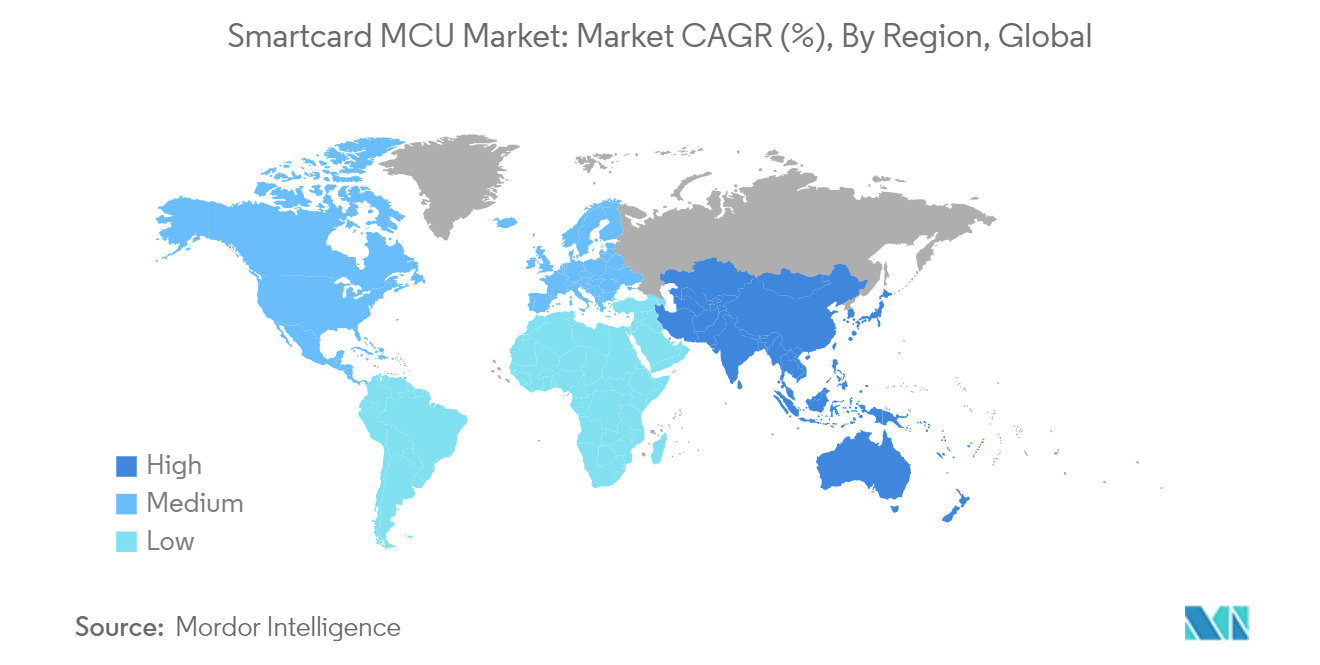
Smartcard MCU Industry Overview
The smartcard MCU market demonstrates semi-consolidation, marked by intensifying competition among major players. This landscape is characterized by fluctuations influenced by growing consolidation, technological advancements, and evolving geopolitical scenarios. With a pronounced emphasis on innovation for sustainable competitive advantage, competition is poised to escalate, buoyed by the anticipated surge in demand from new customers within end-user industries.
In this context, brand identity assumes paramount importance, given the expectations of quality from end-users in microcontroller manufacturing. The market features prominent incumbents like Infineon Technologies AG, Renesas Electronics Corporation, Texas Instruments Incorporated, and STMicroelectronics NV, resulting in high market penetration levels.
September 2023 witnessed the unveiling of the SST ESF3 third-generation embedded SuperFlash technology NVM solution by GlobalFoundries and Microchip Technology, introduced through Microchip's subsidiary, Silicon Storage Technology (SST). Now available for production in the GF 28SLPe foundry process, this cutting-edge solution has garnered commendation from GF's clientele. It boasts remarkable performance, exceptional reliability, a diverse array of IP options, and cost efficiency, finding ideal applications in advanced MCUs, intricate smart cards, and IoT chips for consumer and industrial use.
In June 2023, Samsung Electronics introduced a biometric card IC featuring an all-in-one payment solution, promising an innovative payment experience. This new fingerprint security chip earned recognition as the winner of the CES 2023 Best of Innovation Awards in the Cybersecurity & Personal Privacy category.
Smartcard MCU Market Leaders
-
NXP Semiconductors N.V.
-
Infineon Technologies AG
-
STMicroelectronics
-
Texas Instruments Incorporated
-
Microchip Technology Inc.
*Disclaimer: Major Players sorted in no particular order
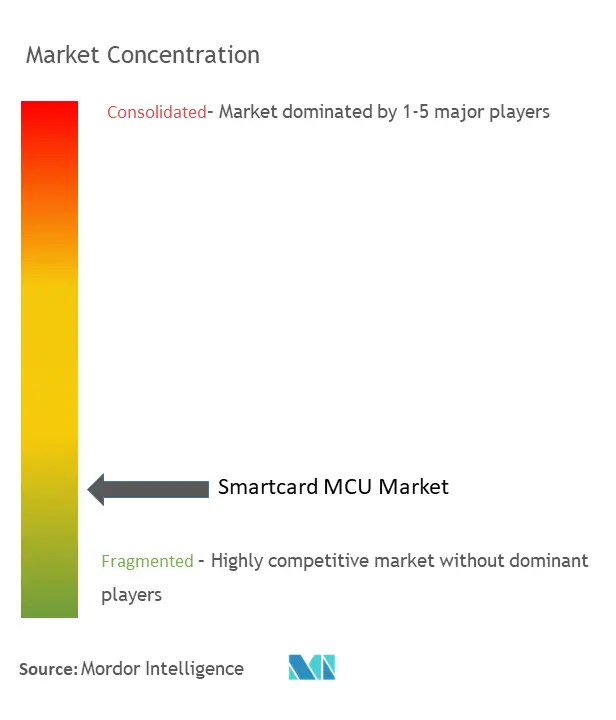
Smartcard MCU Market News
- April 2023: STMicroelectronics introduced a selection of microcontrollers, which are built on the ARM7 (TM) Thumb(R) core family developed by ARM (LSE: ARM). This new range, known as the STR71xF series, offers a variety of communication interfaces, including I2C, SPI, UART, CAN, USB, HDLC, MMC, and Smart Card interfaces. STMicroelectronics emphasized its established presence in the market for 8- and 16-bit MCUs and expressed its intention to venture into the 32-bit domain with this ARM-based family.
- March 2023 - NXP introduced a new chip that consolidates a microcontroller, an NFC front end, and security into a single IC. The PN7642 facilitates internal key storage and hardware crypto processing, which speeds up secure authentication in hardware, surpassing the speed of a pure software implementation. The PN7642 is highly integrated and customizable, which reduces the size and cost of NFC-based system designs, making an additional MCU optional. The MCU side includes an Arm Cortex M33 core and 180 KB of programmable flash memory.
Smartcard MCU Market Report - Table of Contents
1. INTRODUCTION
- 1.1 Study Assumptions and Market Definition
- 1.2 Scope of the Study
2. RESEARCH METHODOLOGY
3. EXECUTIVE SUMMARY
4. MARKET INSIGHTS
- 4.1 Market Overview
-
4.2 Industry Attractiveness - Porter's Five Forces Analysis
- 4.2.1 Bargaining Power of Suppliers
- 4.2.2 Bargaining Power of Consumers
- 4.2.3 Threat of New Entrants
- 4.2.4 Intensity of Competitive Rivalry
- 4.2.5 Threat of Substitutes
- 4.3 Industry Value Chain Analysis
- 4.4 Impact of COVID-19 and Macroeconomic Trends on the Market
5. MARKET DYNAMICS
-
5.1 Market Drivers
- 5.1.1 Rapid Development of Digital Technologies
- 5.1.2 Increasing Investments by Governments in Transportation Systems
-
5.2 Market Challenges
- 5.2.1 Growing Popularity of Mobile or Digital Wallets
6. MARKET SEGMENTATION
-
6.1 By Product
- 6.1.1 8-bit
- 6.1.2 16-bit
- 6.1.3 32-bit
-
6.2 By Functionality
- 6.2.1 Transaction
- 6.2.2 Communication
- 6.2.3 Security and Access Control
-
6.3 By End-user Industry
- 6.3.1 BFSI
- 6.3.2 Telecommunications
- 6.3.3 Government and Healthcare
- 6.3.4 Education
- 6.3.5 Retail
- 6.3.6 Transportation
- 6.3.7 Other End-User Industries
-
6.4 By Geography
- 6.4.1 North America
- 6.4.2 Europe
- 6.4.3 Asia
- 6.4.4 Australia and New Zealand
- 6.4.5 Latin America
- 6.4.6 Middle East and Africa
7. COMPETITIVE LANDSCAPE
-
7.1 Company Profiles
- 7.1.1 NXP Semiconductors NV
- 7.1.2 Renesas Electronics Corporation
- 7.1.3 Infineon Technologies AG
- 7.1.4 STMicroelectronics
- 7.1.5 Microchip Technology Inc.
- 7.1.6 Idemia Group
- 7.1.7 Thales group
- 7.1.8 Giesecke+Devrient
- 7.1.9 Zilog, Inc.
- 7.1.10 Samsung Electronics Co. Ltd
- *List Not Exhaustive
8. INVESTMENT ANALYSIS AND MARKET OUTLOOK
** Subject To AvailablitySmartcard MCU Industry Segmentation
Smart card microcontrollers are specialized microcontrollers designed to be used in smart cards. These cards are used in a variety of applications, such as payment cards, access control cards, and identification cards. These cards are typically more secure and tamper-resistant than general-purpose microcontrollers as they are often used to store sensitive data, such as financial information or personal identification information.
The smartcard MCU market is segmented by product (8-bit, 16-bit, and 32-bit), by functionality (transaction, communication, security & access control), by end-user industry (BFSI, telecommunications, government and healthcare, education, retail, transportation, and other end-user industries), and by geography (North America, Europe, Asia Pacific, and Rest of the World).
The report offers market sizes and forecasts in value (USD) for all the above segments.
| By Product | 8-bit |
| 16-bit | |
| 32-bit | |
| By Functionality | Transaction |
| Communication | |
| Security and Access Control | |
| By End-user Industry | BFSI |
| Telecommunications | |
| Government and Healthcare | |
| Education | |
| Retail | |
| Transportation | |
| Other End-User Industries | |
| By Geography | North America |
| Europe | |
| Asia | |
| Australia and New Zealand | |
| Latin America | |
| Middle East and Africa |
Smartcard MCU Market Research FAQs
How big is the Smartcard MCU Market?
The Smartcard MCU Market size is expected to reach USD 3.32 billion in 2024 and grow at a CAGR of 5.29% to reach USD 4.29 billion by 2029.
What is the current Smartcard MCU Market size?
In 2024, the Smartcard MCU Market size is expected to reach USD 3.32 billion.
Who are the key players in Smartcard MCU Market?
NXP Semiconductors N.V., Infineon Technologies AG, STMicroelectronics, Texas Instruments Incorporated and Microchip Technology Inc. are the major companies operating in the Smartcard MCU Market.
Which is the fastest growing region in Smartcard MCU Market?
Asia Pacific is estimated to grow at the highest CAGR over the forecast period (2024-2029).
Which region has the biggest share in Smartcard MCU Market?
In 2024, the Asia Pacific accounts for the largest market share in Smartcard MCU Market.
What years does this Smartcard MCU Market cover, and what was the market size in 2023?
In 2023, the Smartcard MCU Market size was estimated at USD 3.14 billion. The report covers the Smartcard MCU Market historical market size for years: 2019, 2020, 2021, 2022 and 2023. The report also forecasts the Smartcard MCU Market size for years: 2024, 2025, 2026, 2027, 2028 and 2029.
Smartcard MCU Industry Report
Statistics for the 2024 Smartcard MCU market share, size and revenue growth rate, created by Mordor Intelligence™ Industry Reports. Smartcard MCU analysis includes a market forecast outlook 2029 and historical overview. Get a sample of this industry analysis as a free report PDF download.



